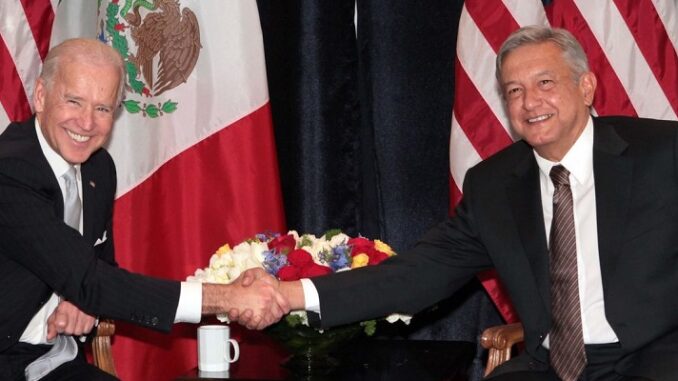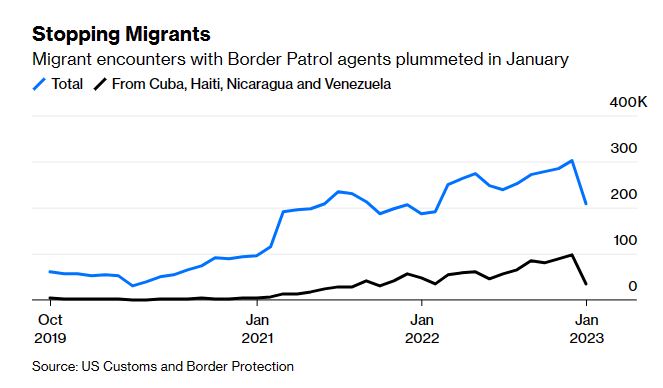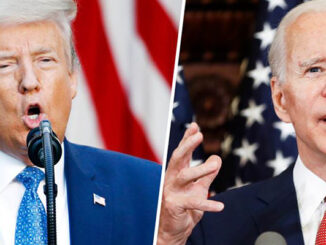
The Biden administration’s desperation to solve its border problem threatens to undermine a more critical priority: developing a richer strategic relationship with its neighbor.
by Eduardo Porter, Bloomberg
Something is afoot in American immigration policy.
Out of the blue, on Monday, Feb. 6, Mexico’s foreign ministry issued a statement to categorically reject restarting the Remain In Mexico program under which the Trump administration sent tens of thousands of Central Americans to Mexico to wait while US judges decided on their asylum request.
The following Wednesday, the Washington Post published an article stating that Mexico and the US were negotiating Remain in Mexico on steroids — a deal to send non-Mexican migrants back across the southern border. It “could allow U.S. authorities to carry out large-scale deportations of non-Mexicans back across the border,” as the Post put it.
The Department of Homeland Security rushed to deny the story. But the denial left an open door: “We’re continuing to work closely with the govt of Mexico to implement our successful border enforcement plan,” tweeted a DHS spokeswoman. Indeed, hounded by Republicans in the House and with an election approaching , President Joe Biden hopes to find some relief from one of his biggest headaches.
It’s likely to prove harder than he thinks.
He is in a hurry. On May 11, the official pandemic health emergency will be over. With it will end the legal rationale the US used to craft a deal in January to summarily expel tens of thousands of prospective migrants from Cuba, Haiti, Nicaragua and Venezuela to Mexico on ostensibly health-related grounds.
If nothing is put in its place, Washington may lose the best deterrent it has come up with to stop the political nightmare of thousands upon thousands of desperate migrants massing at the southern border.
Under the earlier January arrangement, the US is offering up to 30,000 temporary visas per month to prospective migrants from these four countries as long as they have a sponsor in the US and apply online before coming. And Mexico agreed to take back up to the same number of migrants nabbed trying to gain entrance to the US at the border, including those trying to apply for asylum here.
Thus far, the carrot of a visa for those who follow the rule combined with the stick of assured expulsion for those who don’t has been a surprisingly effective deterrent. US agents ran into fewer than 36,000 migrants from the four countries in January, down from more than 98,000 in December. Total “encounters” of prospective migrants with the Border Patrol fell to just over 200,000, the fewest since February of last year.

With Republicans calling for DHS Secretary Alejandro Mayorkas’s head, the idea that the deal might expire and desperate migrants might again launch themselves at the border is a terrifying prospect.
A more ambitious version of the deal, on the other hand, might conceivably fix Washington’s problem, at least for a little while. “They seem to be convinced that if they turbocharge the mechanism implemented in January, that it will continue to deliver declining numbers,” noted Arturo Sarukhan, former Mexican ambassador to the US.
And yet the dueling messages last week suggest that crafting a new arrangement to build on the expulsions under the Title 42 public health law, which used the Covid emergency as cover for what was essentially migration policy, might not be as straightforward as Washington hopes.
Mexico, like most countries, does not usually accept non-citizens deported from other countries, a legal wrinkle that Title 42 helped to smooth over. Any expansion of expulsions to Mexico under a yet to be defined new legal framework, and maybe from a growing list of countries — Border Patrol agents nabbed 62,000 Colombians and 45,000 Ecuadoreans in the first four months of the fiscal year that began in October, as well as 57,000 Guatemalans and 52,000 Hondurans — will likely run into legal and political hurdles.
The first is persuading Mexico to go along with a deal that, to many Mexicans, brings few benefits.
“Frankly, It’s not clear what the compensation is, only the subordination is clear,” said Tonatiuh Guillén Lopez, former head of Mexico’s National Migration Institute during the first six months of the administration of President Andrés Manuel López Obrador. “It would turn Mexico into a docile complement of the US’s migration policy,” he added.
And the question of what’s in it for Mexico has political ramifications. The pre-campaign for the Mexican presidency is already underway. Foreign Minister Marcelo Ebrard, who would likely sign any new arrangement, is one of the hopefuls jockeying to be anointed as successor by Lopez Obrador. And rival camps have already slammed him for cutting the Remain in Mexico deal, selling Mexican sovereignty down the river.
Critics of Lopez Obrador point out that he is getting plenty from the Biden administration in exchange for offering up Mexico as a wall against migrants — most notably a blind eye toward his growing authoritarianism, nationalistic energy policies and other decisions that would, in normal times, meet with Washington’s loud disapproval.
More sympathetic observers point out that Mexico is probably also gaining directly from the deterrent, preventing thousands of prospective migrants from setting off to Mexico with the final goal of entering the US. It likely calculates that agreeing to accept tens of thousands of migrants expelled from the US doesn’t mean they will actually show up.
“The Mexican government would not be thrilled to take hundreds of thousands of returned migrants since they don’t really want to have to solve the problem for the US government,” said Andrew Selee, president of the Migration Policy Institute. “But they seem to be willing to collaborate on things that would keep the numbers down, which also means few real returns in practice.”
This part of the deal is imperiled, though. Led by Texas, attorneys general from Republican states are asking the courts to block the Biden administration’s use of the migration parole process, under which it is offering the temporary visas that are the deal’s carrots. If their lawsuit succeeds, and numbers of non-Mexican migrants trudging their way across Mexico rebound in any significant way, Mexico could well back out. “The sponsorship deal is part of the enforcement strategy,” Selee said. “Losing it imperils the Mexican government’s cooperation.”
And yet Washington’s approach exhibits a remarkable shortsightedness. American immigration policy cannot be about deterrence alone. The US exerts too strong a pull on the displaced and the vulnerable for such a policy to succeed. Beyond the ethical dilemma of barring those most in need, a strategy so heavy on deterrence squanders the opportunity that so many willing migrants offer a country that, ultimately, needs them.
Equally important, President Biden’s urgency to resolve a political problem risks derailing a critical priority: North America’s future prosperity and security depend on the US and Mexico developing a rich strategic relationship with economic and cultural linkages, cooperation on law enforcement and criminal justice, conversations on technology and its regulation.
Migration will surely play a large role in this relationship. But the conversation can’t be held hostage by an American imperative that Mexico become its immigration wall.
To contact the author of this story: Eduardo Porter at [email protected]
Eduardo Porter is a Bloomberg Opinion columnist covering Latin America, US economic policy and immigration. He is the author of “American Poison: How Racial Hostility Destroyed Our Promise” and “The Price of Everything: Finding Method in the Madness of What Things Cost.”



